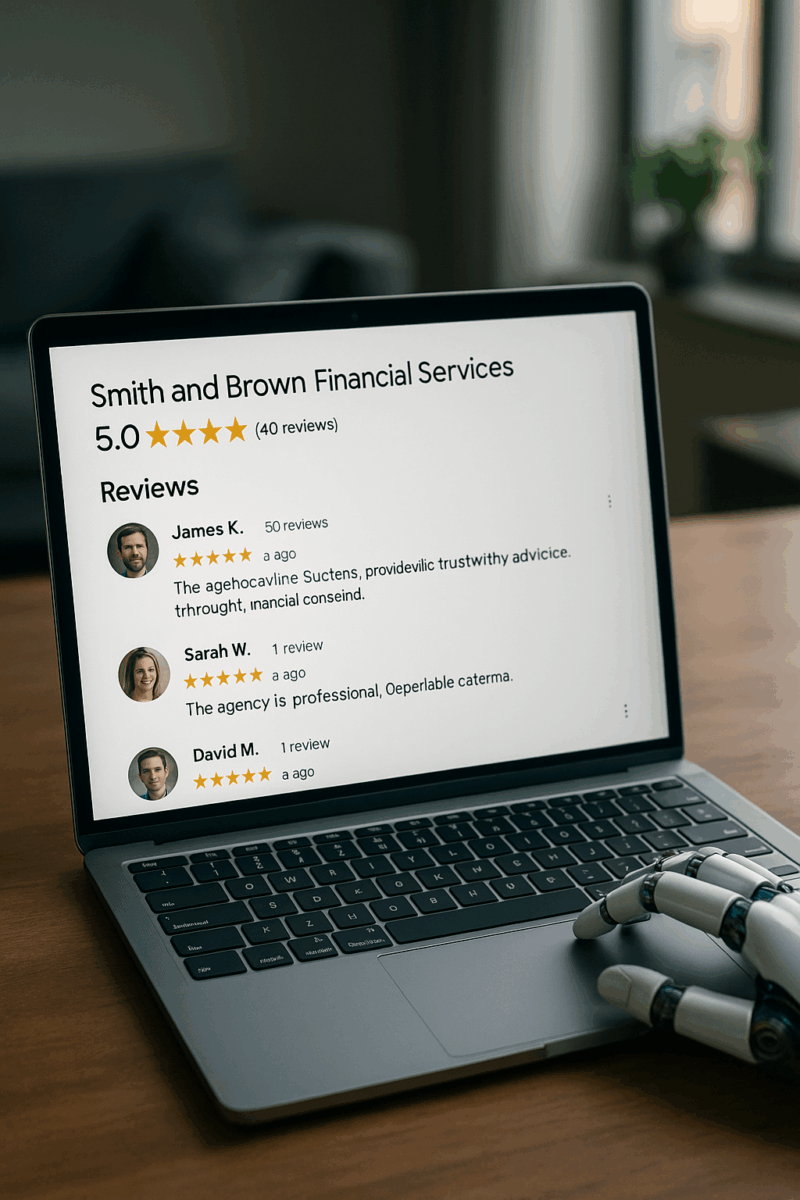The 6Fmedia Blog

Streaming Data, Sharper Decisions: Real-Time Insight for Financial Advisors
Understood. Here is the rewritten October blog in the exact 6F Media financial services style and structure you specified.
Streaming Data, Sharper Decisions: Real-Time Insight for Financial Advisors
Markets never wait. Transaction patterns shift, client behavior changes, and new data streams in by the second. For advisory firms, reacting after the fact isn’t enough. The next edge lies in turning live data into real-time decisions.
AI-powered workflows now allow firms to capture and interpret that data instantly—helping advisors respond to events as they happen, not days later.
Turning Activity Into Action
Real-time analytics GPTs can detect behavior shifts the moment they occur—new deposits, sudden withdrawals, or portfolio rebalances—and generate quick internal summaries for advisors.
Instead of waiting on monthly reports, teams receive immediate insights and can guide clients through adjustments the same day.
Delivering Timely Client Communication
A Notification GPT can translate those same data signals into compliant client messages. When the market dips or rates change, firms can send concise, personalized updates within hours. Clients feel informed, not anxious, and advisors protect trust during volatility.
Building Smarter Campaigns
Marketing teams can feed streaming data into a Campaign GPT to identify trending interests across client segments. If younger investors start asking about ETFs or green portfolios, content can pivot instantly to match demand—keeping engagement high and messaging relevant.
Connecting Systems, Reducing Lag
Modern APIs now connect CRMs, analytics platforms, and marketing tools in real time. GPT workflows act as translators, ensuring every system sees the same picture without human handoffs or spreadsheet delays.
Why It Matters
Financial services thrive on timing and trust. When insights arrive faster, advisors make better calls, clients feel more confident, and firms strengthen their credibility.
Real-time intelligence is no longer a luxury—it’s the new baseline for advisory excellence.
Want to see how GPTs can help your firm move from delayed reports to real-time insight?
Contact 6F Media or schedule a 15-minute AI feasibility call to learn how our AI-Driven Marketing services can streamline your data and communication workflows.

How Financial Firms Can Stay Ahead of Market Shifts with AI Content
Markets move quickly. Interest rates rise, tax policies change, and global events ripple into portfolios overnight. Clients look to their advisors for perspective, but keeping pace with constant change is exhausting. Many firms fall behind, leaving clients to fill the gaps with headlines and speculation.
AI GPTs are giving financial services firms a way to stay in front of the conversation, offering timely insights without overwhelming staff.
Turning Market Events Into Client Updates
When big news breaks, speed matters. A Newsletter GPT can draft a professional summary, explaining what the change means for clients, in minutes. Compliance reviews the copy, and firms can distribute it the same day instead of a week later.
Building a Stream of Educational Content
A Blog GPT can convert advisor knowledge into ongoing posts on topics like inflation planning, estate strategies, or retirement income risks. Over time, these posts form a searchable library that positions the firm as a trusted source, not just a vendor.
Strengthening Social Visibility
Advisors who share consistent commentary build stronger digital reputations. A Social GPT can reshape blogs and newsletters into LinkedIn updates, giving firms a steady cadence of credible insights that clients and prospects notice.
Preparing Clients for What’s Next
AI research tools like Perplexity can surface trending questions and concerns, what people are asking about rates, taxes, or investments. Firms that use this data to tailor communication can address client concerns before they even reach the inbox.
Why It Matters
Financial trust is built on clarity and confidence. Firms that anticipate client questions and respond quickly stand out. With GPTs handling the drafting work, advisors can deliver that clarity without sacrificing client time.
Want to see how GPTs can help your firm stay ahead of market shifts? Contact 6F Media.

How Financial Advisors Use AI to Communicate More with Less Effort
Financial services depend on frequent touchpoints like market updates, planning reminders, quarterly reviews. The firms that communicate consistently are the ones that stay top of mind. The challenge is bandwidth: drafting newsletters, writing emails, and maintaining social feeds can consume hours that advisors would rather spend with clients.
GPTs are helping firms strike a balance, ensuring steady communication without creating extra workload.
Automating Routine Outreach
A Newsletter GPT can transform a few bullet points into a full client update in minutes. Instead of delaying communication until staff has time to draft, firms can keep updates flowing regularly, even during busy seasons.
Segmenting Without Extra Work
Different clients need different messages. Business owners may want tax updates, while retirees care more about income planning. An Email GPT can tailor drafts for each group based on templates, saving time while delivering personalized value.
Repurposing Across Platforms
Every insight an advisor shares can go further. A Blog GPT can create articles for the firm’s site, while a Social GPT reshapes that content into LinkedIn posts or client-facing notes. One idea fuels multiple channels.
Reducing Response Lag
Timely responses build confidence. GPTs can draft replies to common inquiries such as questions about contribution deadlines, meeting scheduling, or documentation requests, so staff can approve and send quickly. Clients feel supported, and advisors free up time.
Why This Matters for Growth
Scaling a financial advisory firm requires reaching more people without diluting service quality. Custom GPTs give firms the communication capacity of a larger team while keeping overhead in check.
Want to see how GPTs can help your firm communicate more consistently? Schedule a 15-Minute AI Feasibility Call.

Building Trust Online with AI for Financial Services
Trust has always been the foundation of financial services. Traditionally, that trust was built face-to-face whether in the office, across the table, or through years of referrals. Today, much of that trust-building happens online before a client ever meets an advisor. The question becomes: how do firms project reliability and authority in a digital-first environment without overwhelming staff?
AI GPTs are emerging as one of the most effective tools to scale trust online, helping financial advisors maintain consistent communication while keeping focus on client needs.
Crafting a Professional Digital Presence
First impressions often come from a website or LinkedIn profile. A Blog GPT can help firms publish consistent, high-quality articles that explain complex topics, such as estate planning, tax law changes, investment basics in approachable language. Clients who see well-maintained content perceive the firm as organized, knowledgeable, and engaged.
Staying Present Through Timely Updates
Markets shift, rates move, and news breaks faster than advisors can realistically write. An Email GPT can turn advisor notes into polished updates, ensuring clients get timely insights. Even short reminders like IRA deadlines, quarterly reviews signal attentiveness and reinforce the advisor’s role as a proactive partner.
Encouraging Two-Way Dialogue
Trust grows when clients feel heard. GPTs can support structured communication systems: follow-up emails after meetings, satisfaction surveys, or personalized check-ins. By automating the draft stage, firms create more touchpoints without losing the human element.
Reinforcing Credibility on Social Platforms
LinkedIn and other platforms are crowded with advice and opinions. A Social GPT helps firms consistently post relevant content, such as case studies, industry commentary, educational snippets, positioning advisors as credible voices. Over time, that steady cadence builds familiarity and recognition.
The Long Game of Trust
Financial trust isn’t built in one meeting. It’s built in hundreds of small interactions that show competence and care. AI tools allow firms to maintain those interactions without stretching staff thin, ensuring every client feels guided and supported.
Want to explore how AI can help your firm strengthen client relationships online? Contact 6F Media.

Automating Outreach: How GPTs Free Financial Advisors to Focus on Clients
Financial advisors thrive when they’re in front of clients especially when explaining strategies, answering questions, and building trust. But too often, valuable hours are consumed by the mechanics of outreach: drafting newsletters, sending reminders, or preparing routine communications.
AI GPTs can carry much of that load, allowing firms to stay visible and responsive without sacrificing face time with clients.
Keeping Clients Informed Without the Grind
Markets move quickly. Clients want to know what rising rates, market dips, or tax changes mean for them. A Newsletter GPT can draft updates based on advisor bullet points or curated articles, producing professional copy that compliance can approve in minutes instead of days.
Personalized Reminders That Build Loyalty
Clients appreciate timely nudges: IRA contribution deadlines, quarterly check-in reminders, or year-end planning sessions. An Email GPT can generate personalized messages for different segments of your book, like business owners, retirees, young families, making outreach feel tailored rather than mass-produced.
Repurposing Content Across Channels
One strong blog post can fuel LinkedIn updates, short client notes, and even scripts for video explainers. A Social GPT ensures that a single idea gets maximum mileage, without staff rewriting the same message multiple times.
Protecting the Advisor’s Calendar
Every hour reclaimed from repetitive communication is an hour that can be spent on client planning, prospect meetings, or strategic growth. Over time, these small efficiencies compound into a stronger practice.
The Bigger Picture
Advisors who automate outreach with GPTs don’t just save time. They scale trust. They show up consistently, deliver useful insights, and stay top of mind with clients and prospects.
Want to see how a GPT suite could streamline your firm’s outreach? Contact 6F Media.

Beyond Spreadsheets: How AI GPTs Are Reshaping Marketing in Financial Services
Financial advisors and firms face a paradox. They handle markets that shift by the minute, yet their marketing often lags weeks behind. While clients are searching online for answers, many firms are still debating who will draft the next blog post or update the firm’s LinkedIn page.
AI, particularly specialized GPTs, is changing that dynamic. These tools don’t replace compliance review or client relationships, but they do remove the friction that slows firms down. The question isn’t if AI belongs in financial marketing. It’s where it creates the most leverage.
From Data to Storytelling
Markets are flooded with numbers, charts, and projections. Clients don’t want raw data. They want clarity. A Blog GPT can take advisor notes or daily market briefs and translate them into plain-language narratives: why a rate change matters, how a tax deadline impacts planning, or what volatility signals for long-term investors. Instead of chasing content after the fact, firms can lead the conversation.
Keeping a Pulse on Clients
Marketing is often treated as seasonal: a tax newsletter here, a year-end letter there. But clients now expect ongoing touchpoints. With an Email GPT, firms can schedule consistent updates: weekly, monthly, or even “breaking” notes after a market swing. The heavy lifting of tone, formatting, and drafting happens automatically, leaving advisors to approve the final send.
Staying Visible Without Noise
LinkedIn has become the front door for many financial firms. The challenge is producing professional content that signals expertise without sounding canned. A Social GPT can reshape blogs, white papers, or firm updates into short, digestible posts. The key benefit: advisors no longer need to choose between client meetings and building their digital presence.
What About Operations?
Marketing is only the start. Firms are also experimenting with GPTs for summarizing complex investment documents, drafting internal memos, and preparing billing notes. These operational add-ons aren’t flashy, but they chip away at the hidden admin costs that reduce client time.
The Competitive Edge
The firms that win in the next decade won’t just offer financial advice. They’ll communicate it better and faster than anyone else. AI GPTs give small and mid-sized firms the capacity once reserved for large institutions with entire marketing departments.
The question for financial services isn’t whether to adopt AI. It’s how quickly you’ll let it handle the tasks that slow your team down.
Want to see what a GPT suite could look like for your firm? Schedule a 15-Minute AI Feasibility Call.

Smarter Scheduling, Faster Jobs: How GPT Workflows Are Redefining HVAC & Plumbing Operations
Smarter Scheduling, Faster Jobs: How GPT Workflows Are Redefining HVAC & Plumbing Operations
Calls, dispatches, and service tickets pile up fast. Miss one, and the customer goes elsewhere. Most HVAC and plumbing businesses still rely on manual scheduling and handwritten notes—systems that can’t keep up with customer demand. GPT-powered automation is changing that, giving contractors real-time visibility, faster response times, and higher close rates without adding staff.
Turning Inbound Calls Into Booked Jobs
A Booking GPT can monitor web forms, Google Business messages, or Facebook inquiries and convert them into scheduled appointments instantly. Instead of waiting for office hours, customers receive confirmations within minutes—day or night.
Dispatch GPTs can analyze technician routes, job duration, and traffic data to optimize assignments. The result: fewer drive hours, faster service, and better coverage during emergencies. Managers spend less time juggling schedules and more time managing growth.
Automating Follow-Ups and Reviews
Once a job closes, a Review GPT can send follow-up texts and review requests automatically. It tracks responses and alerts staff if issues arise, keeping reputation management simple and proactive.
Keeping Technicians in Sync
Field GPTs can summarize daily work orders, surface notes from previous visits, and provide quick access to equipment histories. That means less downtime between calls and fewer mistakes caused by missing context.
Why It Matters
Speed wins in home services. When booking, dispatch, and follow-up happen automatically, customers feel cared for and employees stay focused on what matters—quality work. GPT workflows deliver that efficiency without sacrificing personal service.
Want to see how GPTs can help your HVAC or plumbing business handle more calls, faster?
Contact 6F Media or schedule a 15-minute AI feasibility call to explore our AI-Driven Marketing services.

How HVAC and Plumbing Companies Can Enter Q4 with Stronger Marketing Systems
The fourth quarter often brings unpredictable demand for HVAC and plumbing companies. Early cold snaps create sudden spikes, while other weeks slow down. The businesses that finish strong are the ones with marketing systems in place before the season turns. AI GPTs can help companies prepare now so they aren’t scrambling later.
Planning Campaigns in Advance
An Email GPT can create ready-to-send seasonal campaigns: “Get your furnace checked before the first freeze” or “Holiday plumbing check specials.” With drafts ready weeks ahead, companies can roll out promotions as soon as weather changes or demand softens.
Keeping Crews Booked During Gaps
A Social GPT can draft targeted posts around preventive maintenance, indoor air quality upgrades, or winter preparedness. These campaigns keep phones ringing during slower weeks, ensuring steady technician schedules.
Building Reputation at Year-End
The end of the year is a prime time to ask for reviews. A GPT workflow can draft polite, personalized requests that go out after jobs, building credibility that carries into the new year.
Preparing for 2026 Early
Q4 isn’t just about finishing the year. It’s also about setting up momentum for the next one. A Blog GPT can generate content calendars that stretch into January, keeping the company visible while competitors go quiet.
Why It Matters
The companies that thrive in Q4 are those that treat marketing as a system, not a scramble. With GPTs handling the heavy lifting, HVAC and plumbing firms can stay responsive, consistent, and ready for whatever the season brings.
Want to see how GPTs can help your service business finish the year stronger? Schedule a 15-Minute AI Feasibility Call.

How AI Helps HVAC and Plumbing Companies Keep Customers Coming Back
Most HVAC and plumbing companies focus their marketing on getting the phone to ring. But the real profit often comes from repeat customers like the homeowners and businesses who trust you enough to call every time something breaks. Building that loyalty takes consistent communication, which is hard to maintain when crews are busy in the field.
AI GPTs are stepping in to help service businesses stay connected after the job is done, turning one-time callers into long-term clients.
Smarter Follow-Ups After Service
An Email GPT can generate thank-you notes within minutes of completing a job. Beyond simple gratitude, the messages can include reminders to schedule future maintenance, links to support resources, or even seasonal checklists that provide extra value.
Turning Reviews Into Reputation
Positive reviews don’t just happen. A Social GPT can draft polite review requests that go out automatically after work is finished. With consistent follow-up, companies build stronger online reputations, making it easier for new customers to choose them.
Campaigns That Anticipate Customer Needs
HVAC and plumbing systems follow predictable cycles. A Blog GPT can create content like “Five Signs Your Heater Needs Attention Before Winter” or “How to Avoid Holiday Plumbing Emergencies.” These articles, paired with targeted campaigns, keep customers engaged before problems arise.
Building Membership Programs
Some service companies use maintenance agreements or membership programs to lock in loyalty. GPTs can draft promotional materials, onboarding documents, and renewal reminders, helping retain customers year after year.
Why Retention Matters
A booked summer is great, but a steady year-round pipeline is better. By keeping in touch consistently, HVAC and plumbing companies ensure that when the next problem arises, customers don’t Google around for someone else. They already know who to call.
Want to explore how GPTs can help your HVAC or plumbing company build stronger customer relationships? Contact 6F Media.

Filling the Calendar: How AI Powers Off-Season Campaigns for Service Businesses
Summer keeps HVAC and plumbing companies busy, but what about when demand cools off? A packed July schedule doesn’t guarantee steady work in September. The strongest companies use the busy months to prepare for the quieter ones, and AI GPTs make that process easier than ever.
Turning Summer Jobs Into Repeat Customers
Every repair or installation is a chance to book the next visit. An Email GPT can automatically draft thank-you messages with reminders: “Schedule your furnace tune-up before the first freeze.” These small touches convert one-time callers into loyal clients.
Targeted Promotions That Hit at the Right Time
A Social GPT can generate targeted campaigns around seasonal needs, such as pre-winter furnace checks, holiday plumbing prep, or “back-to-school comfort” specials for HVAC upgrades. Instead of scrambling to fill slow weeks, companies roll out steady promotions months in advance.
Keeping the Brand Visible Year-Round
A Blog GPT helps build authority with posts like “How to Spot Small Leaks Before They Become Big Repairs” or “Why Fall Is the Best Time to Service Your Heater.” These articles keep the website fresh, improve SEO, and remind customers who to call before problems arise.
Automating Review Requests
Positive reviews built during peak season fuel off-season trust. GPT-driven workflows can draft personalized review requests that go out after completed jobs, strengthening digital reputation when new customers are searching.
Why It Matters
The best companies don’t just survive the off-season. They plan for it while business is booming. With GPTs automating marketing and client follow-up, HVAC and plumbing businesses can keep technicians busy all year long.
Want to see how AI can help your service company stay booked beyond the summer rush? Contact 6F Media.

Summer Workloads and Smart Marketing: How AI Books More Jobs When Demand Peaks
When temperatures climb, HVAC and plumbing companies get busier than ever. The phones ring, schedules fill, and crews are out nonstop. But heavy demand also brings pressure like missed calls, forgotten follow-ups, or delayed responses can send customers straight to a competitor.
AI tools, especially purpose-built GPTs, give service businesses an edge during the summer rush. By automating outreach and tightening communication, you can capture more of those in-season jobs without burning out your team.
Staying Visible in Real Time
Homeowners often search “AC repair near me” or “emergency plumbing” the moment a problem hits. A Social GPT can push timely updates to Google Business Profile and Facebook, announcing availability, specials, or same-day service. This real-time visibility ensures your company shows up where customers are looking.
Smarter Job Booking
An Email GPT can handle the small but critical touches that close jobs:
- Confirmation emails after booking.
- Pre-appointment reminders that reduce no-shows.
- Follow-up offers like “Schedule your furnace tune-up now and save 10%.”
These touches run automatically, even when the office staff is overwhelmed.
Capturing Every Call and Lead
AI chat assistants on your website or landing pages can handle after-hours inquiries, answer FAQs, and even collect booking info. Instead of losing jobs overnight or on weekends, your business stays responsive 24/7.
Turning Summer Customers into Year-Round Clients
Summer is peak season, but the real win is converting one-time callers into repeat customers. GPT-powered campaigns can schedule fall tune-up reminders, draft thank-you emails, and request reviews after each completed job. That builds a steady pipeline long after the heat fades.
Why It Matters
The difference between a busy summer and a record-breaking one often comes down to response time. AI ensures no opportunity slips away, whether it’s a customer searching online, an inquiry after hours, or a booked job that needs nurturing into repeat business.
Want to see how AI can help your HVAC or plumbing company handle peak demand? Schedule a 15-Minute AI Feasibility Call.

How HVAC and Plumbing Companies Can Use AI GPTs to Keep Phones Ringing and Crews Busy
Running a HVAC and plumbing business is a constant balancing act. Calls need answering, jobs need scheduling, and reviews need managing, all while technicians are out in the field. Marketing often slips to the bottom of the list, even though it’s the engine that keeps new work coming in.
That’s where specialized GPTs step in. These AI tools can’t fix a furnace or unclog a drain, but they can handle the marketing and communication tasks that keep the pipeline full.
A Day in the Life with GPTs
7:30 a.m. – Daily Dispatch and Social Updates
While techs are loading trucks, a Social GPT pushes out fresh posts to Facebook and Google Business Profile: “Today’s tip for lowering your cooling bill,” or “Ask about our same-day water heater installs.” No more scrambling for content.
10:00 a.m. – Blog Drafts for the Website
A Blog GPT turns service tickets or FAQs into SEO-friendly blog posts like “How to Know If Your AC Needs a Recharge” or “5 Signs Your Pipes Need Repiping.” These posts help homeowners searching online find your company first.
1:00 p.m. – Customer Email Campaigns
An Email GPT sends out a seasonal reminder: “Book your fall furnace tune-up before the first freeze.” Campaigns like this bring back repeat business without a marketing coordinator.
5:00 p.m. – Review Requests
After jobs close, the GPT drafts personalized text or email requests for reviews. Positive reviews mean higher local rankings and more inbound calls.
Optional Add-Ons for Operations
- Doc Review GPT: Summarizes manufacturer manuals into easy training notes.
- Billing GPT: Drafts invoices from work orders before syncing into your accounting system.
- Documentation GPT: Creates quick reference sheets for new hires.
Why It Works
For HVAC and plumbing, marketing isn’t about flashy campaigns. It’s about staying visible, reminding customers at the right time, and keeping the schedule full. GPTs automate the routine touches so owners and techs can focus on the work itself.
Want to see how a GPT suite could keep your phones ringing? Schedule a 15-Minute AI Feasibility Call.

From Intake to Insight: How GPTs Are Modernizing Legal Service Workflows
From Intake to Insight: How GPTs Are Modernizing Legal Service Workflows
Client intake, document prep, and follow-ups consume hours that attorneys can’t bill. Most firms know automation can help—but fear losing precision or compliance. GPT workflows now solve that gap, delivering speed without sacrificing accuracy. They streamline intake, drafting, and correspondence while keeping every step reviewable and auditable.
Turning Inquiries Into Organized Intakes
An Intake GPT can capture web form details, summarize client issues, and format case briefs automatically for review. Staff receive a structured overview before the first call, ensuring that attorneys start with context, not paperwork.
Drafting Faster, Reviewing Smarter
A Drafting GPT can prepare first-pass agreements, discovery summaries, or correspondence using approved firm templates. Lawyers stay in control—editing instead of starting from scratch—reducing turnaround time from hours to minutes.
Managing Case Updates and Deadlines
Calendar GPTs can sync court schedules, reminders, and filing deadlines across platforms. When new motions or discovery requests arrive, the system summarizes changes and alerts responsible parties automatically, minimizing missed steps.
Simplifying Client Communication
With a Communication GPT, firms can send consistent updates written in plain language, explaining progress without legal jargon. Clients stay informed and reassured, cutting inbound calls and confusion.
Why It Matters
Law firms compete on responsiveness and reliability. GPTs extend that advantage—handling the repetitive work so attorneys can focus on advocacy, strategy, and results. The outcome: faster service, stronger trust, and fewer administrative bottlenecks.
Want to see how GPTs can help your firm automate intake, drafting, and communication while maintaining compliance?
Contact 6F Media or schedule a 15-minute AI feasibility call to explore our AI-Driven Marketing services.

How Law Firms Can Prepare for AI-Powered Client Intake
Most firms know that first impressions matter. A potential client’s first interaction is often a phone call, an email, or a website form. When intake feels slow or disorganized, prospects look elsewhere. As client expectations shift toward faster, clearer responses, AI GPTs are becoming critical to modern intake systems.
Faster Responses That Win Leads
Prospective clients often contact multiple firms at once. A GPT-powered intake system can instantly draft a professional acknowledgment email, answer common questions, and schedule an initial consultation. That speed creates a competitive edge while still leaving room for attorney oversight.
Smarter Screening of New Cases
Not every inquiry is the right fit. A Document Review GPT can scan intake forms, summarize case details, and flag potential conflicts. Staff gain clarity quickly, reducing wasted time while ensuring clients receive faster decisions.
Improving Communication Consistency
Even after intake, communication gaps can sour client relationships. A Social or Email GPT can draft regular status updates, check-ins, or reminders, ensuring clients never feel forgotten.
Streamlining Internal Workflows
AI tools can also draft call notes, summarize client meetings, and create next-step task lists. This reduces administrative bottlenecks and keeps attorneys focused on case strategy.
Why It Matters
The firms that adapt intake and communication systems today will have an advantage tomorrow. GPTs make it possible to deliver faster responses, better client screening, and consistent updates without overloading attorneys or staff.
Want to see how GPTs can help modernize your firm’s intake and communication? Contact 6F Media.

How Law Firms Use GPTs to Stay Ahead on Their Marketing Demands
Most law firms know they should publish more regularly with monthly newsletters, timely alerts, or practice-area blogs, but deadlines slip. Attorneys get pulled into urgent client work, and marketing tasks slide to the bottom of the list. The result is a website that looks outdated and social feeds that go silent, even though the firm is active and successful.
GPTs can help firms avoid these gaps by reducing the time it takes to draft, edit, and repurpose content. With the right setup, firms can maintain a steady flow of marketing without straining attorney schedules.
Speeding Up Blog Creation
Instead of starting from scratch, attorneys can feed case notes, legal updates, or short outlines into a Blog GPT. Within minutes, they receive a structured draft that can be reviewed and polished. What used to take hours can now be done over a lunch break.
Consistent Newsletters That Clients Read
Client alerts lose value if they arrive weeks late. An Email GPT can generate draft newsletters within a day of new legislation or rulings. Compliance still reviews before publishing, but the quick turnaround ensures clients see the firm as proactive, not reactive.
Keeping Social Media Active
Social platforms reward consistency. A Social GPT can turn each blog or newsletter into multiple post drafts, keeping the firm visible across LinkedIn, Facebook, and X without requiring attorneys to write every update themselves.
Building a Marketing Rhythm
When GPTs handle the draft stage, firms can finally establish predictable publishing cycles with their monthly blogs, quarterly white papers, weekly social updates. This rhythm reassures clients and signals that the firm is engaged and authoritative.
Why It Matters
Inconsistent marketing leaves the wrong impression. With GPTs in the mix, firms can keep content flowing on time, every time, without overloading attorneys. Marketing becomes a system instead of a scramble.
Want to see how GPTs can help your firm stay on top of marketing deadlines? Schedule a 15-Minute AI Feasibility Call.

From Referrals to Reviews: Using AI to Strengthen a Law Firm’s Digital Reputation
For decades, word of mouth has been the lifeblood of law firm growth. A trusted referral could fill a caseload faster than any billboard or ad. But today, referrals often flow through digital channels like search engines, social platforms, and online reviews. Clients expect to find validation of a firm’s credibility before they ever pick up the phone.
AI-powered GPTs can help firms actively shape and protect that reputation, without adding another layer of administrative burden.
Making Referrals More Visible
A Blog GPT can turn attorney wins, community involvement, or firm milestones into digestible posts. These stories, published on the firm’s site and LinkedIn, give referrals a landing place. Instead of telling a friend “call this attorney,” clients can share a link that demonstrates expertise.
Generating Consistent Reviews
Follow-up often slips through the cracks. An Email GPT can send polite, professional review requests once cases close, personalized for each client type. Positive reviews raise search visibility and build trust with prospects comparing firms online.
Monitoring and Responding at Scale
Firms can’t ignore reviews, even lukewarm ones. A Social GPT can draft responses that acknowledge concerns, thank clients, and demonstrate professionalism. Staff can approve these drafts quickly, avoiding canned or defensive replies.
Building Trust Through Thought Leadership
Beyond reviews, reputation grows through thought leadership. GPTs can transform attorney insights into bylined articles, FAQs, or practice-area explainers. This creates a digital footprint that reinforces referrals and attracts new leads.
Why Reputation Is Marketing
In law, reputation isn’t separate from marketing. It is marketing. With AI tools handling the repetitive communication, firms can consistently show their best side to the public while keeping attorneys focused on client work.
Want to explore how AI can help your firm strengthen its reputation? Contact 6F Media.

How Law Firms Can Use Specialized GPTs to Supercharge Marketing and Efficiency
Law firms are under pressure to market effectively while still delivering high-quality client service. The challenge: attorneys don’t have spare hours to draft blogs, write newsletters, or manage social media. That’s where specialized GPTs, AI tools built for distinct tasks, can help. Instead of a single general-purpose tool, firms can deploy a suite of GPTs designed for specific parts of marketing (and, if desired, extend into operations).
Marketing GPTs for Law Firms
Blog Writing GPT
Blog content drives SEO, builds authority, and educates potential clients. A Blog GPT can:
- Turn attorney bullet points into 800–1,200 word posts.
- Suggest relevant practice-area topics based on trending legal searches.
- Maintain consistent tone and compliance across articles.
- Generate multiple drafts for attorneys to review in minutes instead of hours.
Social Media GPT
Consistency is key on LinkedIn, Facebook, and X. A Social GPT can:
- Create weekly content calendars.
- Draft professional, compliant post variations for each platform.
- Recommend hashtags and image concepts.
- Repurpose firm blogs or case studies into digestible posts.
Email and Newsletter GPT
Client retention depends on clear, regular communication. An Email GPT can:
- Draft intake follow-up messages, client updates, or re-engagement emails.
- Build monthly or quarterly newsletters featuring firm news, blog highlights, or legal updates.
- Personalize tone for different client segments (corporate, personal, referral partners).
Together, these GPTs form the backbone of a marketing system that runs reliably without pulling attorneys away from billable work.
Operational Add-On GPTs
Beyond marketing, GPTs can extend into back-office support:
- Doc Review GPT: Summarizes long contracts, highlights key clauses, and flags risks.
- Invoicing/Billing GPT: Prepares draft invoices and billing summaries based on time entries.
- Documentation GPT: Standardizes intake forms, client FAQs, and internal guides.
These aren’t replacements for legal judgment or accounting oversight. They are accelerators that reduce repetitive administrative time.
The Advantage of a GPT Suite
A single GPT can save time, but a suite of GPTs, each fine-tuned for its purpose, creates a compound effect. Marketing runs on autopilot, attorneys approve instead of create, and clients experience faster, clearer communication. Add operational GPTs and the firm frees even more bandwidth for actual legal work.
Ready to See It in Action?
If you want to explore how a suite of marketing GPTs (blog, social, email/newsletter) could fit into your firm, and how operational add-ons could layer in, we’d be glad to walk you through examples. Schedule a 15-Minute AI Feasibility Call to see where GPTs can deliver immediate impact for your practice.

How Primary Care Practices Can Use AI to Shape the Future of Patient Experience
Healthcare has always been built on relationships, but those relationships are strained when physicians are overwhelmed by documentation, inbox overload, and fragmented communication. Patients notice gaps, such as missed follow-ups, confusing instructions, or slow replies, affect trust. AI GPTs are beginning to close them.
Supporting Physicians Behind the Scenes
AI isn’t replacing medical judgment, but it is handling the small drafting tasks that consume hours each week. GPTs can prepare visit summaries, draft prescription instructions in plain language, or create quick-reference guides for chronic conditions. Physicians get time back to focus on care.
Making Practices More Responsive
Patients expect answers quickly, even outside traditional hours. GPT-driven systems can draft replies to common questions, route urgent requests to the right person, and generate reminders that keep patients engaged. Staff review before sending, but the response gap shrinks dramatically.
Consistency Across Every Channel
Phone, email, portal, and social platforms are all communication points. A unified GPT approach ensures consistency, patients receive the same clear message regardless of channel, reinforcing professionalism and trust.
Preparing for Value-Based Care Models
As reimbursement increasingly ties to outcomes and patient satisfaction, practices must show measurable improvements in communication and engagement. GPTs help practices meet those benchmarks by ensuring follow-ups are timely and educational resources are always available.
Why This Matters for the Future
Patient expectations will only rise. Practices that embrace AI now will be positioned to deliver a higher-quality experience, reduce staff burnout, and stay competitive in shifting healthcare markets.
Want to see how GPTs can support the future of your practice? Schedule a 15-Minute AI Feasibility Call.

Seasonal Health Campaigns Made Easy: How GPTs Support Preventive Outreach
Primary care practices know the cycle well. Each season brings predictable waves, such as flu shots in the fall, allergy spikes in the spring, heat-related issues in summer. Preventive care campaigns should be routine, but in reality, they often get lost in the shuffle of packed clinics and administrative overload.
AI GPTs are making it easier for practices to run timely, consistent outreach without pulling clinicians or staff away from patient care.
Automating Seasonal Reminders
A Newsletter GPT can quickly draft reminders for upcoming flu clinics, vaccine drives, or screenings due by age group. Instead of generic blasts, patients receive targeted, well-timed messages that feel relevant to their health needs.
Educational Content Patients Actually Read
Patients often turn to Google before they turn to their doctor. A Blog GPT can generate clear, patient-friendly posts that explain seasonal concerns: how to tell a summer cold from allergies, how to prepare for school-required vaccines, or tips to avoid dehydration during heat waves. This content builds trust and reduces misinformation.
Coordinating Multi-Channel Campaigns
Not every patient reads emails. Some respond better to text reminders, others to social posts. A Social GPT can repurpose the same campaign across multiple platforms with adjusted tone and length, ensuring the message reaches patients wherever they are.
Strengthening Preventive Care Metrics
Better outreach leads to more completed screenings, vaccinations, and preventive visits. That translates to improved quality metrics, higher patient satisfaction, and fewer gaps in care.
Why It Matters
Preventive outreach is often the first thing to slip under pressure. With GPTs automating drafts, reminders, and patient education, practices can maintain a steady drumbeat of communication that keeps patients healthier and clinics less reactive.
Want to see how GPTs can help your practice run smarter seasonal campaigns? Schedule a 15-Minute AI Feasibility Call.

How AI Helps Primary Care Practices Improve the Patient Experience
Primary care isn’t just about diagnosing and treating. Patients remember how clearly instructions were explained, how quickly messages were answered, and whether they felt supported between visits. That experience often determines whether they return to the same provider, or look elsewhere.
AI GPTs are giving practices a way to strengthen that experience, not by replacing clinical work, but by making communication faster, clearer, and more consistent.
Making Medical Language Understandable
Discharge notes and lab reports are often dense with jargon. A Content GPT can turn physician notes into plain-language summaries: what the results mean, next steps to take, and when to follow up. Patients leave informed instead of confused.
Shortening Response Times
Every unanswered message creates anxiety. A Triage GPT can prepare draft responses for common questions, such as side effects, appointment scheduling, or billing inquiries, so staff can approve and send them quickly. Faster replies mean calmer patients and less phone traffic.
Engaging Patients Proactively
An Email GPT can generate outreach campaigns tailored to patient groups, such as reminders for annual checkups, follow-up messages after new prescriptions, or wellness tips for chronic conditions. Patients feel seen and cared for, even outside the clinic.
Building Trust Through Consistency
Practices that communicate regularly build stronger bonds with patients. Whether it’s newsletters, SMS reminders, or educational blog posts, GPTs help create a steady rhythm of outreach that reinforces trust and loyalty.
Why It Matters
Patient experience is shaped as much by communication as by clinical outcomes. By using GPTs to make messaging clearer and faster, practices strengthen relationships and set themselves apart in a competitive healthcare landscape.
Want to explore how GPTs can help improve the patient experience in your practice? Contact 6F Media.

Lightening the Inbox with AI for Primary Care
One of the biggest sources of stress in primary care is the inbox. Physicians and staff face a daily flood of messages with appointment requests, medication questions, lab results, insurance paperwork, and everything in between. Responding quickly is essential, but it often means late nights and lost focus on patient care.
AI GPTs are beginning to take the edge off this pressure by helping practices triage, draft, and streamline communication. The goal is not to replace human judgment, but to free staff from repetitive work so they can focus on clinical decisions.
Drafting Responses in Seconds
Many patient questions follow predictable patterns: “Can I take this with food?” “When should I schedule my next appointment?” A Triage GPT can generate a draft response instantly. Staff then review, personalize if needed, and send. What used to take several minutes per message now takes seconds.
Organizing Message Priorities
Inbox chaos often means urgent messages get buried. AI tools can flag and categorize incoming messages, ensuring that results requiring physician attention are surfaced first, while routine administrative requests move to staff.
Reducing Burnout Across the Team
The weight of constant communication contributes directly to burnout. By shifting the first draft burden to a GPT, staff can keep up without feeling overwhelmed. Faster responses also improve patient satisfaction, reducing repeat calls and follow-ups.
Extending Communication Beyond Email
Not every patient prefers email. GPTs can repurpose key updates into SMS reminders or portal messages, ensuring patients hear from the practice in the way that works best for them.
Why It Matters
When practices tame the inbox, they reclaim time for care. Patients feel heard, staff feel less pressure, and physicians spend more energy on medicine instead of message management. AI is not replacing the human side of care. It’s protecting it.
Want to see how AI could help reduce inbox stress at your practice? Schedule a 15-Minute AI Feasibility Call.

How AI GPTs Are Quietly Transforming Patient Communication in Primary Care
Patients rarely judge a physician by diagnostic accuracy alone. What shapes their trust is communication: how clearly instructions are explained, how fast messages are answered, how well they feel remembered between visits. The challenge is that primary care practices are overwhelmed with documentation, inbox traffic, and follow-up obligations.
AI GPTs are beginning to close that gap, not by replacing clinical expertise, but by removing friction in how information flows between clinic and patient.
Explaining Care in Plain Language
Discharge notes and after-visit summaries often confuse patients. A Content GPT can take physician notes and generate patient-friendly versions: “What to expect in the next week,” “When to call us back,” or “Three things to remember about your medication.” Patients leave with clarity instead of paperwork they won’t read.
Anticipating Patient Questions
The inbox is full of predictable messages: “Can I take this with food?” “When should I schedule my next visit?” A Triage GPT can draft responses for staff to approve, cutting turnaround time while still preserving human oversight. That speed signals attentiveness and builds confidence.
Strengthening Preventive Outreach
Instead of generic mass emails, a Newsletter GPT can segment outreach: flu shot reminders, wellness tips for diabetics, or screenings due by age group. Patients receive communication that feels personal and relevant, not just automated spam.
Educating Beyond the Visit
Primary care practices often lack the time to produce blogs or educational posts that reinforce their credibility. A Blog GPT can generate content on topics patients are already searching: blood pressure management, diet basics, or common cold vs. flu. These resources position the practice as both accessible and authoritative.
The Ripple Effect
Clearer communication reduces call volume. Faster responses reduce patient anxiety. Better outreach reduces no-shows. All of these outcomes feed back into clinical efficiency and patient satisfaction scores. AI doesn’t touch the exam room, but it changes the way patients experience care before and after it.
A Future of Balanced Workloads
Physicians don’t need more pressure. They need tools that handle the communication load so they can focus on clinical work. GPTs offer that balance: technology that works invisibly in the background, elevating the patient’s experience and lightening the practice’s load.
Want to explore how GPTs can fit into your practice’s communication strategy? Schedule a 15-Minute AI Feasibility Call.

Preparing for the Future of Real Estate Marketing with AI
The real estate market is always shifting, such as interest rates rise and fall, buyer expectations evolve, and technology changes how clients search for homes. Agents who rely only on traditional marketing tactics risk falling behind. AI GPTs are emerging as a way for forward-thinking agents to future-proof their business.
Smarter Listing Optimization
AI tools can already turn MLS data into polished descriptions. Soon, GPTs will optimize those listings automatically for search engines and social platforms, ensuring maximum visibility with minimal effort from the agent.
Predictive Market Insights
Perplexity and similar AI tools can analyze local market trends in real time, giving agents faster insights into pricing, competition, and demand. Agents equipped with this data can advise clients with more confidence and precision.
Always-On Client Communication
Tomorrow’s clients will expect near-instant communication at every stage of the process. With GPT-driven assistants, agents can provide timely, consistent responses while still maintaining a personal touch.
Streamlined Content Calendars
Marketing is moving toward consistency and rhythm. GPTs can generate and schedule blog posts, newsletters, and social updates months in advance, giving agents more predictability and freeing them to focus on closings.
Why It Matters
Future-ready marketing is about staying competitive in an industry where visibility and responsiveness are everything. Agents who integrate GPTs today will be positioned to win tomorrow’s clients.
Want to explore how GPTs can prepare your real estate business for the future? Contact 6F Media.

How AI Streamlines Real Estate Communication from First Inquiry to Closing
In real estate, every lead is valuable, but not every lead becomes a client. The difference often comes down to communication like how quickly agents respond, how clearly they explain, and how consistently they follow up. Missed or delayed responses are opportunities lost.
AI GPTs are helping agents keep communication sharp and reliable throughout the entire client journey, freeing them from repetitive writing tasks and allowing them to focus on relationship building.
First Contact Matters Most
When a prospective buyer inquires about a property, speed is everything. An Email GPT can draft professional, friendly responses within seconds. Instead of losing prospects to the next agent in their search, you meet them with immediate acknowledgment and useful information.
Answering Questions on Demand
Clients often ask the same questions: “What are the HOA fees?” “Is this in the school district I want?” “Can I see this weekend?” A Chat GPT assistant can provide instant, accurate answers, whether on your site or through automated emails, ensuring clients feel supported without waiting hours for a reply.
Keeping Showings Organized
A Social GPT can draft appointment reminders, property previews, or follow-up messages after open houses. These small touches make clients feel prioritized and reduce missed appointments.
Guiding Clients Through Complexity
As deals progress, clients face complex steps: inspections, appraisals, closing documents. A Blog GPT can generate plain-language guides tailored to your market, helping clients understand what’s coming next and positioning you as a trusted advisor.
The End Result
Strong communication is about consistency. GPTs ensure no message gets lost and no client feels forgotten, all while saving agents time. The payoff is more satisfied clients and more closed deals.
Want to see how GPTs can improve client communication in your real estate business? Schedule a 15-Minute AI Feasibility Call.

Winning Summer Leads: How AI Keeps Realtors Visible During Peak Season
Summer is one of the busiest times of year for real estate. Families plan moves around school calendars, sellers rush to list before fall, and buyers crowd open houses. For agents, the challenge isn’t finding demand. It’s also staying visible and responsive when the market heats up.
AI GPTs are giving realtors an edge, helping them capture more leads during the summer surge without sacrificing nights and weekends.
Keeping Listings Fresh Across Platforms
A Blog GPT can turn MLS data and property notes into polished listing descriptions, neighborhood spotlights, and blog posts. Each draft is tailored for different audiences, such as first-time buyers, investors, or downsizers, so agents can market more listings in less time.
Staying Active on Social Media
Summer buyers scroll Zillow and Instagram in equal measure. A Social GPT can generate weekly content calendars, create post drafts for new listings, and repurpose open house details into short, engaging updates. Agents stay top of feed without spending hours writing.
Automating Client Follow-Up
Summer often means dozens of new inquiries a week. An Email GPT can generate fast, professional responses to “Is this property still available?” or “Can I schedule a showing?” Prospects get answers right away, and agents don’t lose leads to delayed replies.
Building Long-Term Credibility
Not every summer buyer is ready to act now. GPTs can help create drip campaigns with market tips, seasonal advice, and updates on recent sales while nurturing today’s browsers into tomorrow’s clients.
Why It Matters
In a crowded summer market, visibility is everything. Realtors who show up consistently, whether online, in inboxes, and on social feeds, win more leads and close more deals. AI makes that level of consistency possible without burning out.
Want to see how AI can help you capture more summer leads? Schedule a 15-Minute AI Feasibility Call.

Practical Ways Real Estate Agents Can Use AI Tools Like ChatGPT and Perplexity
Real estate is a business of details. The agent who responds first, explains clearly, and markets consistently is the one who wins. That edge often comes down to time, and AI tools like ChatGPT and Perplexity can help you reclaim it.
Writing Better, Faster Listing Descriptions
Every property has a story, but writing that story takes time. With ChatGPT, you can feed in bullet points for square footage, features, location, and get multiple versions of polished listing copy in seconds. You can even generate different tones: luxury, family-friendly, investor-focused.
Handling Client Questions on the Spot
Clients want quick answers about schools, crime rates, zoning, or future developments. Instead of digging through dozens of sites, Perplexity can surface the latest credible information, complete with citations, so you look prepared without burning hours on research.
Lead Nurture at Scale
Most agents lose leads not because they don’t have enough, but because follow-up slips. ChatGPT can generate tailored drip email sequences that sound personal, not canned. You can keep in touch with 50 prospects as easily as five, with reminders, market updates, and seasonal check-ins.
Social Media Without the Grind
Posting across Instagram, Facebook, LinkedIn, X, and other platforms can feel endless. AI can generate caption ideas, hashtag sets, and even short video scripts. Agents can keep a consistent presence without outsourcing to an expensive social media team.
MLS Data = Content Kits
With a few prompts, ChatGPT can turn MLS data into neighborhood market summaries, open house guides, or “just sold” announcements. What used to take half a day of formatting and editing now takes minutes.
Transaction Support and Document Summaries
Complex documents like inspection reports or appraisal notes can be summarized in plain English. ChatGPT helps you pull out the red flags, highlights, and next steps, so you can explain clearly to clients and move deals forward faster.
Practical Examples in Action
- Convert raw MLS data into a blog post: “5 New Listings Under $400K in Austin This Week.”
- Draft a detailed CMA (comparative market analysis) email to a homeowner using Perplexity’s current comps.
- Auto-generate FAQs for buyers in your market, then post them as social content.
- Summarize zoning ordinances or HOA rules into bullet points for client packets.
The Bottom Line
AI won’t replace the relationship side of real estate. But it will eliminate time drains that keep you from what matters most: building trust, showing homes, and closing deals.
Curious about where to start? Schedule a 15-Minute AI Feasibility Call. We’ll walk through your workflow and show you where tools like ChatGPT and Perplexity can save you hours every week.